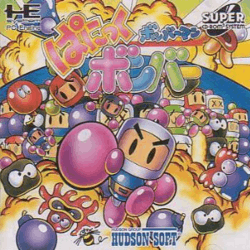Bomberman: Panic Bomber
| Bomberman: Panic Bomber | |
|---|---|
|
Front cover of Bomberman: Panic Bomber for the PC Engine Super CD-ROM² System, the first version. | |
| Developer(s) | Hudson Soft |
| Publisher(s) | Hudson Soft |
| Director(s) | Susumu Hibi |
| Producer(s) | Masato Toyoshima |
| Designer(s) |
Hisanori Takeuchi Hiroshi Yokoyama |
| Programmer(s) | Hisanori Takeuchi |
| Artist(s) |
Hiroshi Yokoyama Masayuki Taguchi Masaru Fujinami |
| Composer(s) |
Kenichi Koyano Jun Chikuma |
| Series | Bomberman |
| Platform(s) | PC Engine, Virtual Boy, Super Famicom, PSP, Neo Geo, Virtual Console |
| Release date(s) |
PC Engine‹See Tfd›
Super Famicom‹See Tfd›
Virtual Boy‹See Tfd›
‹See Tfd›
PSP‹See Tfd›
|
| Genre(s) | Puzzle game |
| Mode(s) | Single-player, Multiplayer (Neo-Geo MVS & AES) |
Bomberman: Panic Bomber (ボンバーマン ぱにっくボンバー) is a 1994 puzzle video game developed and published by Hudson Soft for the PC Engine (in Super CD-ROM² format) on December 22, 1994.
Gameplay
It is a "falling blocks" puzzle game based on the Bomberman franchise. The goal of the game is essentially to cause your opponent to lose by causing their gameplay field to fill to the top with objects. You do this by causing chains of bombs to explode, sending useless rubble over to your opponent's field, which they must then remove themselves. Bombs are earned by causing chains of three identical blocks to disappear. Bombs can only be blown up with an explosion from a lit bomb, which falls from the top of the screen every so often. If the player causes enough damage, they can eventually earn a giant bomb, which will remove a large amount of debris from the playing field, and cause their opponent a good deal of trouble.
The game's regular story mode revolves around Bomberman's hunt for the Golden Bomber statue. During his trek, he fights against several different odd characters, like Drifty the balloon, or Cecil the tiger. However, all that can really be earned from playing through this mode is a harder difficulty level, earned by finishing the entire story at the "hard" difficulty level. The player's progress is saved by a password system.
Development
Ports and related releases
Panic Bomber was ported to the Neo Geo, Virtual Boy (known in Japan as Tobidase! Panibon (とびだせ!ぱにボン) and known in North America simply as Panic Bomber), Super Famicom (known formally in Japan as Super Bomberman: Panic Bomber World (スーパーボンバーマン ぱにっくボンバーワールド), stylistically as Super Bomberman: Panic Bomber W (スーパーボンバーマン ぱにっくボンバーW)), and PlayStation Portable. The Virtual Boy version uses a red-and-black color scheme and parallax, an optical trick that is used to simulate a 3D effect.[1] It was also included in the Nintendo GameCube and PlayStation 2 versions of Bomberman Land 2.
Reception
On release, Famicom Tsūshin scored the Super Famicom version of the game a 22 out of 40,[2] giving the Virtual Boy version a 20 out of 40.[3] The four reviewers of Electronic Gaming Monthly gave the Neo Geo version a 7 out of 10, describing it as a decent if unexceptional Tetris clone, with one reviewer commenting that "This genre is so flooded that it's hard to come up with a unique angle, and there isn't one for Panic Bomber", while the other three argued that the game "has enough originality to make it stand on its own."[4] GamePro remarked that the gameplay and graphics are too simple to justify the game's appearance on the powerful Neo Geo, but praised its play mechanics and addictive nature and concluded, "For a system renowned for fighting games, Panic is a refreshing presence."[5]
See also
References
- ↑ "Backwards Compatible: The Virtual Boy". ABC Good Game. 2009-06-01. Retrieved 2015-04-13.
- ↑ NEW GAMES CROSS REVIEW: スーパーボンバーマン パニックボンバーW. Weekly Famicom Tsūshin. No.327. Pg.37. 24 March 1995.
- ↑ NEW GAMES CROSS REVIEW: とびだせ!ぱにボン. Weekly Famicom Tsūshin. No.347. Pg.30. 11 August 1995.
- ↑ "Review Crew: Panic Bomber". Electronic Gaming Monthly. Ziff Davis (70): 36. May 1995.
- ↑ "ProReview: Panic Bomber". GamePro. IDG (82): 69. July 1995.
